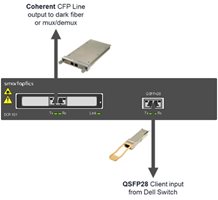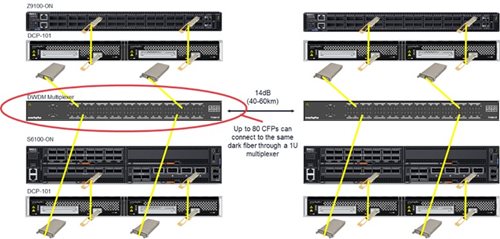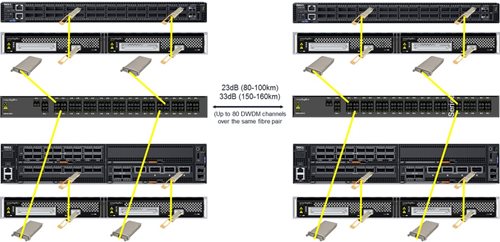PRESS RELEASE
15 March 2017
Contact:
Sean Davies
sean.davies@smartoptics.com
Smartoptics enters into partnership with Dell for 100G optical networking
Smartoptics 100G distance extension solutions based on the DCP-101 transponder and the M-Series intelligent multiplexer have been validated with Dell’s high-performance Z9100-ON and S6100-ON 100G switches. The certified open-line networking solutions overcome the distance limitations of standard transceivers and enable long-distance fiber connectivity, up to 1000 kilometers. The result is simple and cost-effective 100G transmission solutions for connecting Dell switches over dark fiber.
Harnessing the power of open-line networking
Traditionally, telco system vendors have set the rules and requirements for data center design and functionality. Today, the assumptions that all data centers need to be vertically integrated, symmetrical, and share the same networking need are holding organizations back.
Dell and Smartoptics share the philosophy of the
Open Compute Project community (www.opencompute.org) and the view that open systems, rather than vertically integrated solutions, give organizations the freedom to select the connections and architectures that suit their traffic and demands best. Together, Smartoptics and Dell offer simple and cost-effective 100G transmission solutions that enable Dell Ethernet switches to be connected over dark fiber. Cost-effective open-line networking solutions for all types of data center connectivity.
Addressing the challenge of long-distance 100G connectivity
This Solution Brief focuses on the challenge of connecting 100G Ethernet switches over longer distances. While standard transceivers, such as QSFP28 or even CFP2/CFP4, typically offer the perfect fit for data handling and transfer within the data centers or over shorter distances, problems arise when 100G traffic needs to be transported over long distances. Similar challenges emerge when more than one single channel is required or when multiple traffic types need to be connected over the same dark fiber link.
All these challenges can be overcome with simple distance extension solutions for single-channel connectivity or multi-channel DWDM applications from Smartoptics. The Smartoptics open-line connectivity solutions based on the
DCP-101 100G transponder and the
M-Series intelligent multiplexer have been verified with the
Dell Z9100-ON and S6100-ON 100G switch families, offering solutions for simple, cost-effective 100G data center connectivity over dark fiber.
Smartoptics open-line DWDM networking solutions
Smartoptics DCP-101 for 100G inter-data center connectivity
The Smartoptics DCP product family offers a modular plug-and-play platform of DWDM transponders and muxponders tailored for open-line DWDM networking.
The DCP-101 100G transponder offers all the features required for multi-protocol traffic transfer over a dark fiber network without the need for extensive buildup of knowledge or costs. The low-powered 1U modules can be distributed throughout the data center and placed close to where they are needed. DCP-101 is equipped with a QSFP28 client port. The line uplink is a coherent CFP providing an interface for metro and long-distance networking applications.
Smartoptics M-Series - the world’s first distance extending DWDM multiplexer
M-Series is the world’s first distance extending DWDM multiplexer. Designed specifically for open-line networking, it works with any combination of transponders, muxponders and embedded DWDM transceivers. The M-Series 1U platform easily handles all of today’s data protocols and allows for up to 80 simultaneous DWDM channels to be connected to the same dark fiber at 100Gbps per channel.
The M-Series multiplexer comes with integrated channel monitoring, amplification and signal conditioning. The optical channel monitor (OCM) monitors the channels and ensures the traffic is present and at the correct levels. An optical surveillance channel (OSC) creates a dedicated communication channel between network nodes enabling topology discovery and fiber analysis. Pre- and booster EDFA amplifiers allow the switches to be connected over greater distances, up to 1000 kilometers or more.
 Three scenarios for long-distance 100G connectivity
Three scenarios for long-distance 100G connectivity
Three scenarios for long-distance 100G connectivity between Dell Z9100-ON and S6100-ON 100G switches have been verified:
- Distance extension solutions using the DCP-101
- Multiple-channel connectivity between switches using the DCP-101 with passive mux/demuxes
- Long-distance connectivity between switches using the DCP-101 and M-Series
In all scenarios, the Smartoptics DCP-101 transponder is used to convert the SR4/LR4 signal from the switch to a DWDM signal for long-distance networking. This is done by connecting the QSFP28 client transceiver to the output of the Dell switch and then to the client input port on the DCP-101. For a single channel point-to-point connection, the coherent CFP output line signal from the DCP-101 is connected directly to the dark fiber. If more channels are required, the signal can instead be connected over a DWDM multiplexer, allowing for up to 80 channels to be simultaneously transported over the dark fiber, over longer distances.
 DCP-101 100G transponder converts QSFP28 SR4/LR4 to a CFP signal for distance extension and DWDM networking
Scenario 1: 100G distance extension solutions
DCP-101 100G transponder converts QSFP28 SR4/LR4 to a CFP signal for distance extension and DWDM networking
Scenario 1: 100G distance extension solutions
In the first scenario, the Dell Z9100-ON and S6100-ON 100G switches were tested with Smartoptics DCP-101 transponders for simple distance extension solutions. The 100G output signals from the Dell switches are converted to DWDM signals that can be transmitted over longer distances using the DCP-101. The solution removes the distance limitations associated with QSFP28 transceivers by using a coherent DWDM CFP transceiver to connect the output signal of the DCP-101 to the line fiber and carry the signal over longer distances.
 Scenario 2: 100G multi-channel DWDM networking
Scenario 2: 100G multi-channel DWDM networking
The second scenario uses Smartoptics DCP-101 transponders with passive DWDM mux/demuxes (multiplexers/demultiplexers) for providing simple multi-channel distance extension solutions for Dell Z9100-ON and S6100-ON 100G switches.
The mux/demux used is a simple 1U device taking multiple input signals and combining – multiplexing – them together onto a single, common line output. This allows for up to 80 independent traffic channels to be transported over one single dark fiber offering a simple and highly cost-efficient way to connect Dell switches over longer distances.
Two DCP-101 modules can fit into a 1U DCP chassis allowing up to 200G per unit. Multiple DCP-101s can be connected through a single multiplexer.
 Scenario 3: 100G long-distance open-line DWDM networking
Scenario 3: 100G long-distance open-line DWDM networking
The Dell Z9100-ON and S6100-ON 100G switches were tested with Smartoptics DCP-101 transponders and the M-Series intelligent DWDM multiplexers. By taking full advantage of the M-Series distance extension, signal monitoring and amplification capabilities, distance extension solutions with up to 80 simultaneous DWDM channels can be created.
An optical surveillance channel (OSC) builds a dedicated communication channel between network nodes enabling topology discovery and fiber analysis. The optical channel monitor (OCM) monitors the channels and ensures the traffic is present and at the correct levels. Pre- and booster EDFA amplifiers allows the switches to be connected over even greater distances, up to 1000 kilometers.
 Why 100G Ethernet connectivity is gaining ground from 40G
Why 100G Ethernet connectivity is gaining ground from 40G
Ethernet transmission nowadays is made of steps of 100G. The same applies to DWDM. Transporting signals over long distances or a multi-channel DWDM network is made much easier when using 100G.
The main reason for this is the lack of solid options for long distance 40G connectivity with DWDM available. This would typically be handled by combining 40G signals to be transmitted one fiber, with the help of a 100G muxponder. Still, the utilization of wavelength capacity is improved by running one signal per 100G wavelength rather than two 40G per 100G.
Another key consideration is that 100G QSFP28 transceivers have the same physical form factor as 40G QSFP+ transceivers. This means that capacities can be increased 2.5 times with the same size equipment when moving from 40G to 100G connectivity.
Future migration from 100G to 200G and above will require no additional forklifting of the transmission systems. In this way, a data center strategy based on 100G connectivity instead of 40G is a more future-proof path, both from an investment and a network-build perspective.
ABOUT SMARTOPTICS
Smartoptics offers optical transmission solutions making networks more powerful. Expanding bandwidth without the upfront investment or hassle of traditional WDM. Our products allow corporate data centers, governments, hosting solution providers and ISPs to build simple, straightforward and cost effective solutions to fulfill their ongoing and future network capacity needs. Headquartered in Oslo, Norway, Smartoptics is an international provider with thousands of installations all around the world. Our award-winning approach has helped companies from every industry sector stay ahead of expanding network demands.
ABOUT DELL TECHNOLOGIES
Dell Technologies is a unique family of businesses that provides the essential infrastructure for organizations to build their digital future, transform IT and protect their most important asset, information. The company services customers of all sizes across 180 countries – ranging from 98 percent of the Fortune 500 to individual consumers – with the industry’s most comprehensive and innovative portfolio from the edge to the core to the cloud.